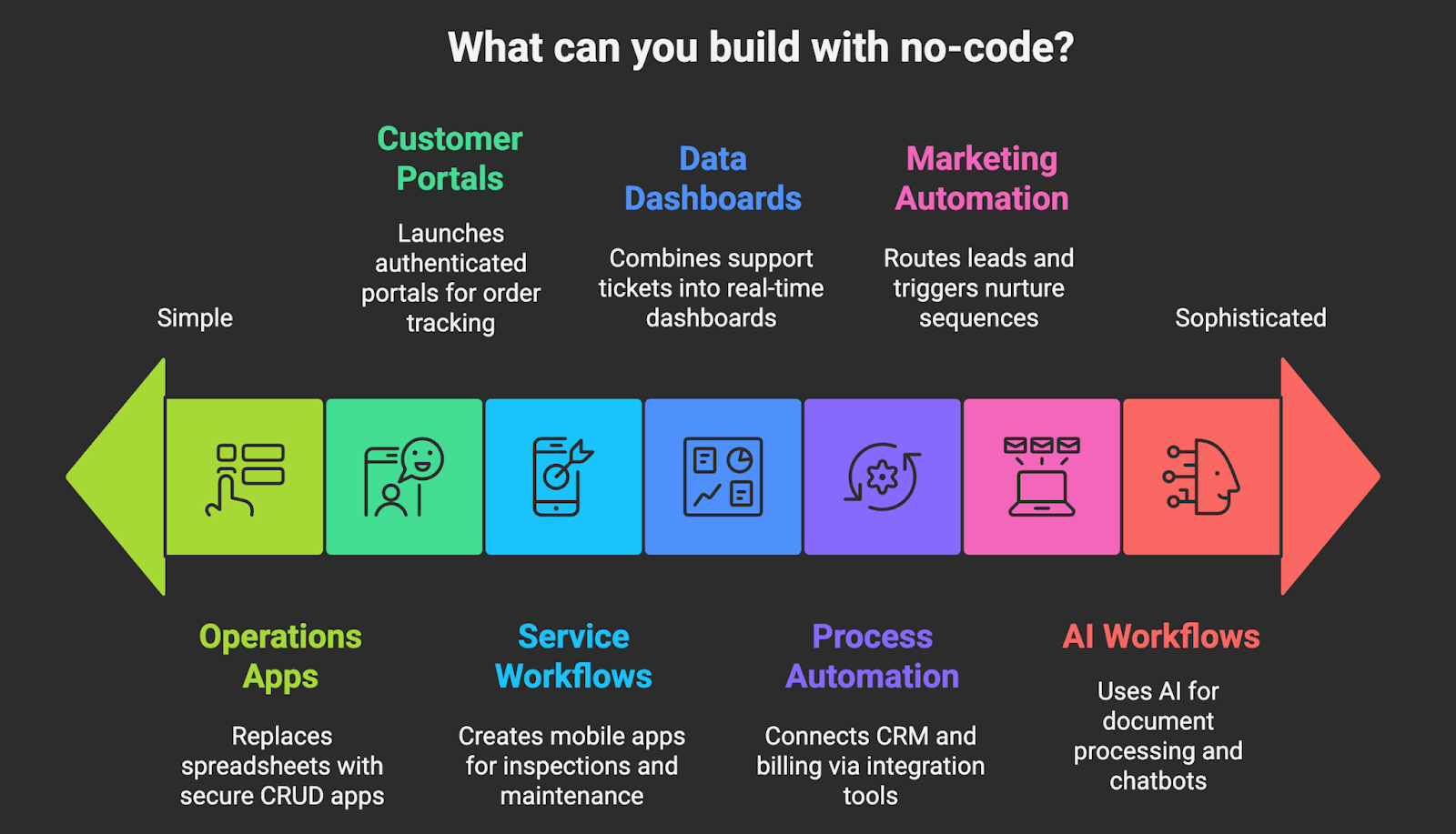No-Code Development and Why It’s Changing the Game
Got a killer app idea but couldn't write a line of code to save your life? Or maybe you're running a business that needs custom solutions like yesterday, but your IT folks are drowning in their backlog? No-code development might be your ticket out of this jam. I'll walk you through what this whole no-code thing actually is, how it works under the hood, and whether it makes sense for what you're trying to pull off. We'll explore the good stuff, the not-so-good stuff, and real ways people are using these tools to build some pretty impressive digital solutions.
What is no-code development?
No-code development lets people create actual, working software without writing a single line of code. Instead of typing out programming languages that look like gibberish to most of us, you'll use visual interfaces where you can drag elements around, drop them where you want, and connect pre-built components to make applications that do exactly what you need.
This approach didn't just appear out of thin air. It evolved because there's this massive gap between how many digital solutions businesses need and the limited number of programmers who can build them. The earliest versions showed up back in the 90s with those super basic website builders (remember GeoCities, anyone?). But the real momentum kicked in around 2015 when companies started desperately looking for ways to digitize everything without having to hire armies of expensive developers.
These days, no-code has grown into this whole ecosystem of platforms that basically democratize software creation. It's putting serious development power into the hands of regular people who understand their business problems better than anyone else, even if they wouldn't know JavaScript from a coffee script.
How does no-code development actually work?
Let's peek behind the curtain of these seemingly magical platforms. Spoiler alert: there's still code involved, you just never have to touch it.
No-code platforms use what tech folks call "abstraction layers" to hide all the complicated coding stuff from you. When you're dragging and dropping elements onto your screen or filling out settings in forms, the platform is secretly generating actual code in languages like JavaScript, Python, or SQL. It's kinda like having a translator who handles a foreign language so you can focus on the conversation.
The technical wizardry typically works like this:
- You visually map out your data structures (think: customer info, product details)
- You set up business rules through simple if/then scenarios ("if customer spends over $100, then add loyalty points")
- You design how everything will look using pre-built visual components
- You connect to other systems you're already using
- The platform generates all the necessary code automatically
Traditional development is sorta like building a car from scratch, designing the engine, transmission, electrical system, everything. No-code is more like assembling a high-end kit car. The complicated parts are pre-manufactured; you're just putting them together in a way that works for you.
Take creating a simple contact form. With traditional coding, you'd need HTML for structure, CSS to make it look decent, JavaScript to check if people filled it out correctly, and server-side code to process what gets submitted. With no-code? Drag a form onto your page, pick what fields you want, connect it to your database with a few clicks, and boom, you're done. The platform handles all that other stuff in the background.
What are the advantages of no-code development?
No-code brings some serious perks to the table that make it attractive for businesses of all sizes:
- Development at warp speed: I've seen projects that would normally take 3-4 months get built in a couple of weeks. You're not reinventing wheels; you're using pre-built components that already work.
- Way less expensive: When Forrester did their research, they found no-code can cut development costs by 60-80% compared to traditional coding methods. That's not chump change.
- Regular humans can build stuff: Marketing managers, HR specialists, operations folks, suddenly they can create solutions to problems they understand intimately without having to explain everything to a developer who might not get the nuances.
- Change your mind? No problem: With traditional development, changing direction mid-project is painful and expensive. With no-code, you can pivot quickly based on feedback or new requirements. Just drag, drop, reconfigure, and you're back in business.
- Less technical debt: You know how old software becomes a nightmare to maintain? Since platforms handle updates to the underlying technology stack, you avoid accumulating outdated code that becomes a money pit over time.
- Innovation from unexpected places: When anyone can build solutions, you get ideas from everywhere in the organization, not just the IT department. Sometimes the best innovations come from people closest to the actual problems.
- Maintenance doesn't eat your life: Updates, security patches, and infrastructure headaches? That's the platform provider's problem now. You focus on making your application better, not keeping the lights on.
Look, I've watched a small manufacturing company build an entire quality control system in two weeks that would have cost them six figures and taken months with traditional development. The playing field is definitely leveling out.
What are the disadvantages of no-code development?
Let's keep it real, no-code isn't all rainbows and unicorns. There are some legitimate limitations you should know about:
- You'll hit walls eventually: These platforms have gotten crazy flexible, but there are still boundaries. If you need something super specialized or complex, you might find yourself banging your head against what the platform can handle.
- Breaking up is hard to do: Once you've built something on a proprietary no-code platform, moving to a different solution later can be quite complicated. You're somewhat married to that vendor's ecosystem and pricing structure.
- Not always the speed demon you want: For applications that need to be blazing fast or handle massive amounts of data, the convenience layers of no-code platforms might introduce some performance hits compared to lean, custom-coded solutions.
- Playing nice with legacy systems can be tricky: While getting better rapidly, some platforms still struggle with connecting to older or specialized systems your business might rely on.
- Security folks get twitchy: If you're handling super sensitive data or have unique compliance requirements, you might need additional security controls beyond what's available out-of-the-box.
- Growth pains are real: Something that works perfectly for a small application might start to show stress fractures when scaled up to enterprise levels. Performance issues or costs can snowball unexpectedly.
- Control freaks beware: If you need complete control over exactly where and how your application is hosted, some no-code platforms might feel too restrictive.
But here's the thing, many of these drawbacks are getting smaller in the rearview mirror as the technology matures. What's a dealbreaker today might be completely solved next year.
What are the main differences between no-code and low-code?
No-code and low-code aren't completely separate things, they exist on a spectrum, with some significant differences in who they're built for and what they can do:
Think about it this way: no-code is like using a microwave with those preset buttons. Press "popcorn" and it just works, fast and convenient but you can't suddenly decide to make crème brûlée. Low-code is more like a microwave that also has manual controls and can switch to convection mode. It takes more skill to use effectively but gives you more options for complex recipes.
I've actually seen companies use both approaches in tandem: no-code for departmental solutions that need to be built quickly, and low-code for more complex applications where developers still want to save time but need more flexibility.
Why choose the no-code development approach?
Companies are jumping on the no-code bandwagon for some pretty compelling strategic reasons:
- Bridge the business-IT Grand Canyon: No-code eliminates the classic "lost in translation" problem where business requirements get mangled on their way to becoming technical specifications. The people who understand the problem are the ones building the solution.
- Bust through backlogs: I talked to an IT director recently whose department had a 9-month backlog for new application requests. No-code lets business units solve their own problems without waiting in that never-ending queue.
- Test before you invest: Even organizations committed to traditional development for final products often use no-code to quickly prototype concepts, gather feedback, and refine requirements before writing a single line of code.
- Let your developers do what they're best at: Why waste expensive developer talent on creating yet another CRUD application when they could be solving the truly complex problems only they can handle?
- Speed up digital transformation: When the pandemic hit, companies that could quickly adapt their digital presence survived. Those that couldn't simply didn't. No-code enables the agility needed to respond to market shifts.
- Reduce "bet the farm" risks: The lower investment and faster deployment of no-code projects reduces the financial risk of new initiatives. If something doesn't work out, you haven't sunk months of development time and mountains of cash into it.
- Unleash your citizen developers: There are problem-solvers throughout your organization who've been creating shadow IT solutions in Excel and Access for years. No-code gives them better tools and brings those solutions into the light where they can be properly managed.
At the end of the day, the decision often boils down to: How fast do you need this? What resources do you have? And how specialized are your requirements? For a surprisingly large number of business scenarios, the speed and accessibility advantages of no-code outweigh the customization limitations.

What are no-code platforms and how do they help?
No-code platforms are essentially specialized software environments that give you everything you need to create applications without having to code. They're comprehensive development ecosystems that handle the technical complexity so you don't have to.
These platforms typically come loaded with:
The market has gotten pretty specialized. Some platforms are amazing for data-heavy business applications but terrible for customer-facing websites. Others excel at process automation but struggle with complex data relationships. Many organizations end up using 2-3 different tools for different needs across their business.
What these platforms are really selling is packaged expertise. They've taken the knowledge of experienced developers about security, scalability, and user experience and wrapped it up in interfaces that regular humans can use. You're standing on the shoulders of giants without having to climb the mountain yourself.
What can you build with a no-code development platform?
The range of applications you can create with modern no-code platforms might surprise you:
- Business Process Applications: A manufacturing client of mine built a quality control system where factory floor workers report issues through a mobile app, managers get automatic alerts based on severity, and everyone sees real-time dashboards of open issues. The whole thing took three weeks to build and deploy.
- Customer Portals and Self-Service Tools: A law firm created a client portal where customers track case progress, access documents, and communicate with their legal team, all complete with the firm's branding and custom workflows for different practice areas.
- Internal Tools and Dashboards: I watched a retail chain develop a store performance dashboard that pulls data from their point-of-sale systems, inventory management, and staff scheduling. Store managers now have a complete picture of operations without juggling multiple reports.
- Mobile Apps: A local restaurant chain built a loyalty app where customers place orders, earn points, and receive personalized offers. They integrated it with their existing POS system and launched in under a month.
- Content Management Systems: A trade publication created a custom CMS that handles their unique editorial workflow, manages relationships between articles in a series, and publishes to multiple channels automatically.
- E-commerce Solutions: A specialty food producer built an online store with custom product bundles, subscription options, and an unusual shipping calculator for perishable goods that would have been impossible with off-the-shelf e-commerce platforms.
- Data Collection and Survey Tools: A healthcare provider created a patient intake system that asks different questions based on symptoms and medical history, routing information to appropriate departments automatically.
The real advantage is how precisely these applications can fit your specific business processes. Instead of changing how you work to fit generic software, you can create solutions that match exactly how your organization operates. And when business needs evolve (as they always do), these applications can change just as quickly.

How can Makeitfuture help you with no-code development solutions?
No-code is a force multiplier when the problem is well suited to standard patterns, integration, and speed. It is not a silver bullet for every system. The winning move is to pair no-code with strong governance and a clear ROI target, deliver quickly, then scale what works.
Makeitfuture helps C suite leaders, IT directors, and operations executives deliver outcomes, not just apps. We design the target operating model, select the right platform for your use case portfolio, implement guardrails, and build the first two or three impactful solutions with your teams so capability sticks. From there, we coach your fusion teams and set up a Center of Excellence for sustainable scale. Explore how we approach delivery and governance with our no-code development services.
If you want proof points, review selected case studies where we automated onboarding, accelerated approvals, and launched customer portals on platforms like Microsoft Power Platform, Webflow, and Airtable.
Ready to evaluate a candidate process or MVP and quantify the ROI? Talk to our team about a discovery sprint that takes you from idea to live pilot in two to four weeks.














.png)
.png)



.avif)
